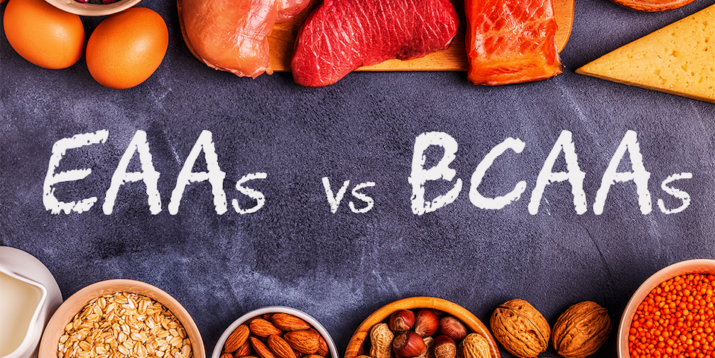EAAs vs BCAAs: What’s the Difference?

For years, athletes have supplemented their diets with branched-chain amino acids (BCAAs) because they believed BCAAs gave them a leg up on muscle recovery and muscle growth. But recent findings have shifted the scientific community’s understanding of how amino acids work together, suggesting that essential amino acids (EAAs) may be a more effective option.
The conflicting information has led to more questions than answers. For example, what’s the difference between EAAs vs BCAAs? Are EAAs better than BCAAs? Do EAAs build muscle?
To get to the bottom of the quandary between EAAs and BCAAs, we spoke with Paul Falcone, principal scientist at BODi. Here’s what he (and the research) had to say.
What Is the Difference Between BCAAs and EAAs?

EAAs and BCAAs are shorthand for types of amino acids, which are the molecules from which protein is made. Protein is the macronutrient that’s largely responsible for building and repairing the body’s tissues, a process also known as protein synthesis.
When we consume protein, the digestive system breaks it down into amino acids, which are released into the bloodstream and processed by the liver before being used by the body.
Of the 20 amino acids utilized by the body, nine are considered “essential,” which means they must be consumed in food. (The body can manufacture the other 11 non-essential amino acids on its own.) And of these nine essential amino acids, three are known as branched-chain amino acids, or BCAAs: leucine, isoleucine, and valine.
Falcone explains that BCAAs share a similar, unique chemical structure, which is why they’re grouped together. It’s also why they were once believed to play similar roles in protein synthesis — an assumption that’s now in question.
“It became evident in the scientific literature that certain amino acids were driving the signaling of muscle protein synthesis,” Falcone explains. In other words, all the amino acids play a role in building and repairing muscle tissue, but certain ones appear to initiate and direct the process.
“At first, it seemed that those (signaling amino acids) were branched-chain amino acids,” says Falcone. “But then it became clear that it was really leucine that was driving muscle protein synthesis, and that valine and isoleucine were not having as much of an effect.”
While valine and isoleucine are critical to muscle building, they don’t play the same signaling role as leucine.
Are EAAs Better Than BCAAs?
While structured a little differently from other essential amino acids, BCAAs are EAAs, so comparing the two can be problematic. Furthermore, all EAAs, including BCAAs, are essential to protein synthesis, as well as other biological functions related to normal growth and development.
EAAs are only “better” than BCAAs in that they represent a more complete grouping of necessary amino acids.
Should You Take BCAAs or EAAs?

When choosing between BCAA or EAA supplements, Falcone’s recommendation is to opt for a well-balanced EAA supplement that meets the daily requirements for adults and contains between 700 and 3,000 milligrams of leucine. This formula will provide your body with the complete profile of EAAs that it needs to build and repair tissues.
A protein supplement like Beachbody Performance Recover is also a great option, as it contains EAAs.* However, protein supplements are typically higher in calories than BCAA supplements, and many of them contain fiber, making them a bit heavier than EAA supplements. So, you (and your digestive system) may prefer to save your protein shakes for the post-workout recovery window.
Why Take BCAAs Separately?
According to Falcone, as well as some studies on the efficacy of supplementing with BCAAs, there’s no reason to take them separately. Yes, leucine signals protein synthesis, but without the other EAAs, there’s nothing to trigger.
“Essentially, it’s like having the contractor, but not all the bricks,” Falcone says. “You need all the bricks there for the contractor to be able to do their job.”
*These statements have not been evaluated by the Food and Drug Administration. This product is not intended to diagnose, treat, cure, or prevent any disease.
